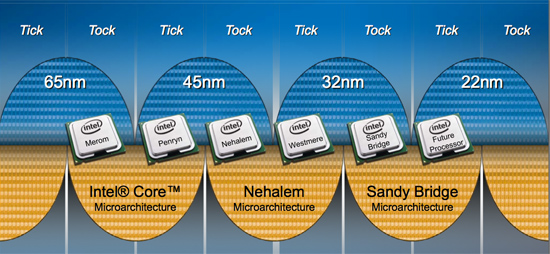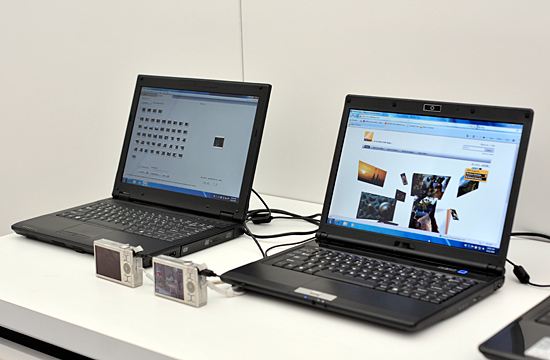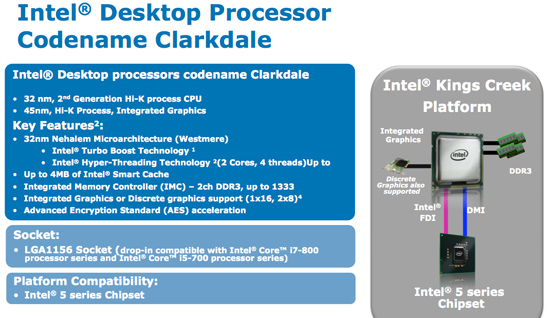The Real Conroe Successor: Clarkdale & All You Need to Know about Westmere
by Anand Lal Shimpi on September 24, 2009 6:00 PM EST- Posted in
- CPUs
Intel spent a lot of time talking about Nehalem a year ago, but not much time on Westmere. It's the tick to Nehalem's tock, or in other words, it's 32nm Nehalem.

Unlike previous die shrinks, we don't get larger caches with Westmere - Nehalem was already too big to begin with. Westmere keeps the same architecture, same cache sizes (or ratios) as Nehalem. It's all built using smaller 32nm transistors and on a smaller die. For the same core count, expect Westmere to be roughly half the size.
But the same core counts aren't what you're going to get. I included the table below in yesterday's Core i7 920XM preview:
| Codename | Market | Cores | Manufacturing Process |
| Bloomfield | Desktop | 4 | 45nm |
| Lynnfield | Desktop | 4 | 45nm |
| Clarkdale | Desktop | 2 | 32nm |
| Clarksfield | Mobile | 4 | 45nm |
| Arrandale | Mobile | 2 | 32nm |
The Westmere products are Gulftown, Clarkdale and Arrandale. That's six, two and two cores. Lynnfield is the last quad-core on the roadmap for the foreseeable future.

We'll talk about Gulftown later, but the focus today is Clarkdale with a little Arrandale.
Meet the 'dales
Arrandale and Clarkdale are the first two Westmere family members you'll meet. Both are technically due out later this year, although we won't see large volumes (by Intel standards) until Q1 2010. Both Arrandale and Clarkdale are dual-core Westmere parts with on-package graphics. The only difference is that Arrandale is mobile while Clarkdale is desktop.

Arrandale running - Hyper Threading helps improve performance even in normal workloads

The desktop socket is LGA-1156, the same socket as Lynnfield. The mobile socket is mPGA-989, the same socket as Clarksfield.










96 Comments
View All Comments
strikeback03 - Friday, September 25, 2009 - link
Remember, there was initially supposed to be a 45nm low end, it was axed and 32nm pulled up. So I wouldn't be surprised to see a 32nm Sandy Bridge, but probably a while after the higher-end versions launch, same as we saw with Nehalem.sunefred - Friday, September 25, 2009 - link
Thats a perfectly sized and nice looking case that the Clarkdale is housed in. Is that comercially available yet?MadAd - Saturday, September 26, 2009 - link
yeah third on that, what itx case is it?MadAd - Saturday, September 26, 2009 - link
nvr mind, its one of the travla serieshttp://linitx.com/viewproduct.php?prodid=10314">http://linitx.com/viewproduct.php?prodid=10314
cdalgard - Friday, September 25, 2009 - link
does anyone know what case is used for the mini-itx system that is shown in this article?KompuKare - Friday, September 25, 2009 - link
"Why not give all chipsets video out support? Intel is big on differentiation. The P55 chipset is a bit more overclocking friendly, a set of optimizations that you won't see in H57. Both types of motherboards will take Clarkdale processors."I do wish reviewers would be a bit harder on Intel with their artificial market segmentation.
My personal pet hate is the game of which CPUs have Intel-VT and which do not. I see a lot of people being disappointed trying to run XP-mode in Windows 7 not to mention trying to run VirtualBox and VMWare properly.
gstrickler - Thursday, September 24, 2009 - link
50%-60% faster than the lousy IGP in G45 when running 3DMark Vantage. The G45 had the X4500HD, so a 50%-60% improvement still puts it at about half the performance of the Nvidia 9400M (G) chipset IGP. Fast enough for daily tasks and maybe games from 4+ years ago. That makes it adequate for HTPC and the casual desktop PC or business PC, but it's still way behind the IGP in Nvidia or AMD chipsets.The whole idea of putting an IGP on the CPU just sounds like a bad idea to me. It's great for embedded SoC systems, but for a GP CPU, I think it's the wrong place for it. Don't want the Intel IGP? Too bad, since they moved the memory controller off the CPU die and onto the die with the IGP, you get it whether you want it or not. Intel is going to force their less lousy IGP into your machine. Hopefully the IGP is fully power gated so that if you're not using it, it at least doesn't cost you power.
I'll wait for some independent tests before I bless or condemn it. 3.33GHz Clarksdale with Turbo Boost and HT enabled is estimated to be almost as fast as a 2.66GHz C2Q on SPEC*Int_rate2006. Let's see, that's 2 cores running at perhaps 3.66GHz + about 33% (for the HT threads) = 7.33GHz * 1.33 = 9.75GHz vs 10.66GHz (4 x 2.66GHz). Allowing a little extra for the IMC and other CPU improvements. Sounds about right on performance, and the power consumption should be down quite a bit.
Aside from the IGP, it sounds pretty good if the price is right.
Inkie - Friday, September 25, 2009 - link
So, what you find wrong with the IGP is that it isn't very good for gaming? It's just a question of degree. No IGP out there is very good, from anyone. Serious (3D graphics) gamers buy graphics cards anyway.gstrickler - Friday, September 25, 2009 - link
No, what I find wrong with the IGP is that it still sucks compared to the IGPs from Nvidia and ATI/AMD. With OpenCL (and maybe DirectCompute), the OS and some applications are starting to use the GPU to accelerate non graphics functions. Given that, putting in an IGP that is significantly lower performance is a performance impediment, even for non gamers.While I have no doubt that Intel will support OpenCL and/or DirectCompute on Larrabee, I don't remember seeing any indication of whether they will support it on this GPU. Even if they do, the performance is likely to be far lower than the performance you would get from an IGP from Nvidia or ATI/AMD.
Like I said, it's "less lousy" than Intel's previous IGPs, and it should actually be adequate for most uses up to low end gaming, but it doesn't have the power to provide many of the benefits that an IGP can provide and there is no reason to build it into the CPU. It should be in the chipset, and like previous generations, you should be able to choose a chipset with it or without it.
Inkie - Saturday, October 3, 2009 - link
Anybody serious about OpenCL or DX 'Compute Shaders' will also buy a discrete GPU, for now.